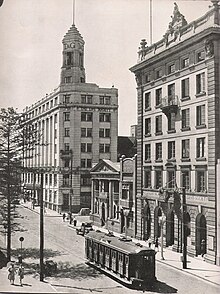
James Watt was a Scottish inventor, mechanical engineer, and chemist who improved on Thomas Newcomen's 1712 Newcomen steam engine with his Watt steam engine in 1776, which was fundamental to the changes brought by the Industrial Revolution in both his native country Great Britain, and the rest of the world.
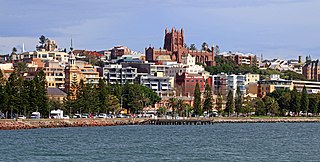
Newcastle or Greater Newcastle, locally nicknamed Newy, is a regional metropolitan area and the second-most-populated district in New South Wales, Australia. It includes the cities of Newcastle and Lake Macquarie; it is the hub of the Lower Hunter region, which includes most parts of the local government areas of City of Newcastle, City of Lake Macquarie, City of Maitland, City of Cessnock, and Port Stephens Council.

Toronto is a lakeside suburb within the City of Lake Macquarie, Greater Newcastle in New South Wales, Australia, approximately 28 kilometres (17 mi) from Newcastle's central business district and is a commercial hub for the sprawling suburbs on the western shore of the lake. It is one of the major centres in the City of Lake Macquarie.

Major General Lachlan Macquarie, CB was a British Army officer and colonial administrator from Scotland. Macquarie served as the fifth Governor of New South Wales from 1810 to 1821, and had a leading role in the social, economic, and architectural development of the colony. He is considered by historians to have had a crucial influence on the transition of New South Wales from a penal colony to a free settlement and therefore to have played a major role in the shaping of Australian society in the early nineteenth century.
102.9 Triple M Newcastle is an Australian radio station, licensed to, and serving Newcastle and surrounds. It broadcasts at 102.9 megahertz on the FM band from its studios in Newcastle. It is owned by Southern Cross Austereo.

Macquarie Street is a street in the central business district of Sydney in New South Wales, Australia. Macquarie Street extends from Hyde Park at its southern end to the Sydney Opera House at its northern end. Apart from connecting these two major landmarks, the key government institutions of the state of New South Wales are all located on this street.
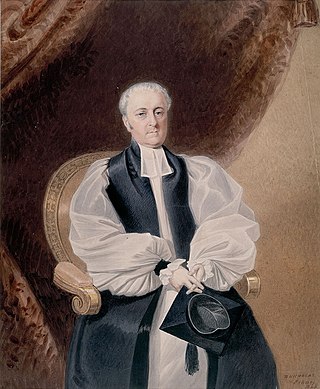
William Grant Broughton was a British Anglican bishop. He was the first Bishop of Australia of the Church of England. The then Diocese of Australia has become the Anglican Church of Australia and is divided into twenty three dioceses.

Belmont is a suburb in the City of Lake Macquarie New South Wales, Australia, located 20 kilometres (12 mi) from Newcastle's central business district on the eastern side of Lake Macquarie.

Paterson is a small township in the lower Hunter Region of New South Wales, Australia. Located within Dungog Shire and City of Maitland, it is situated on the Paterson River. It is in the middle of what was once dairy, timber and citrus country and is now more significantly a feeder town for the nearby mining industry in the Upper Hunter and the city of Newcastle. It was named after one of the first known Europeans in the area was Colonel William Paterson in 1801 surveyed the area beside the river.
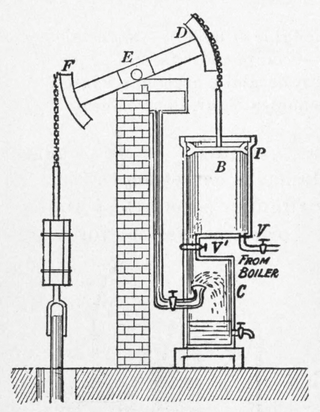
A beam engine is a type of steam engine where a pivoted overhead beam is used to apply the force from a vertical piston to a vertical connecting rod. This configuration, with the engine directly driving a pump, was first used by Thomas Newcomen around 1705 to remove water from mines in Cornwall. The efficiency of the engines was improved by engineers including James Watt, who added a separate condenser; Jonathan Hornblower and Arthur Woolf, who compounded the cylinders; and William McNaught, who devised a method of compounding an existing engine. Beam engines were first used to pump water out of mines or into canals but could be used to pump water to supplement the flow for a waterwheel powering a mill.
Cooks Hill is an inner city suburb of Newcastle, New South Wales, Australia. It is typified by its tree lined streets, rows of Victorian terrace housing, turn of the century timber cottages and corner pubs.

Hunter Street is a major road in the Newcastle central business district, in New South Wales. The street, formerly three separate thoroughfares, extends from Pacific Street in the city's east, to Selma Street in Newcastle West and since 2008 has been the focus of community-led creative enterprises and projects. Established as the city's main street for commercial and retail activity, Hunter Street entered a period of severe decline after World War II. Since 2008, the eastern end of Hunter Street has emerged as a precinct for niche retail and the night-time economy. In June 2012 it was announced that the pedestrian mall between Perkins and Newcomen Streets will be redeveloped by the public and private sectors to stimulate the city's ongoing revitalisation.

The Hill is an inner city, residential suburb of Newcastle, in the Hunter Region of New South Wales, Australia, located immediately south of Newcastle's central business district. The Hill is filled with historic Victorian terraces and is the site of a historic convict prison block. As of January 2021, the average house price in The Hill was A$1.92m.
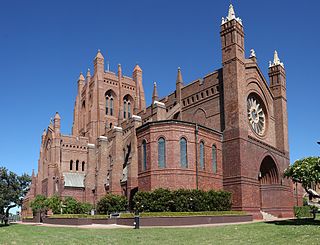
The Cathedral Church of Christ the King, also called Christ Church Cathedral, is an Anglican cathedral in Newcastle, New South Wales. It is the cathedral church of the Diocese of Newcastle in the Anglican Church of Australia. The building, designed by John Horbury Hunt in the Gothic Revival style, is located on a hill at the city's eastern end in the suburb called The Hill. It was added to the New South Wales State Heritage Register on 28 June 2011.
Archaeological evidence indicates that human beings have inhabited the area around Newcastle, New South Wales for at least 6500 years. In 2009, archaeologist uncovered over 5,534 Aboriginal artefacts, representing three occupation periods. In the 1820s, the Reverend Lancelot Threlkeld worked with local Awabakal man Biraban to record the Awabakal language. Since 1892, the Indigenous people of Newcastle have come to be known as the Awabakal.

Henry Dangar (1796–1861) was a surveyor and explorer of Australia in the early period of British colonisation. He became a successful pastoralist and businessman, and also served as a magistrate and politician. From 1845 to 1851 Dangar was a Member of the New South Wales Legislative Council.

St John's Cathedral is a heritage-listed, Anglican cathedral in Parramatta, City of Parramatta, Sydney, New South Wales, Australia. St John's was given the status of provisional cathedral of the Anglican Diocese of Sydney in 1969, and designated a Regional Cathedral in 2011 for the Western Region. It was added to the New South Wales State Heritage Register on 5 March 2010.

Newcastle Government House is a heritage-listed former military post and official residence and now park and psychiatric hospital at 72 Watt Street, Newcastle, New South Wales, Australia. It is also known as Newcastle Government House and Domain, Newcastle Military Barracks & Hospital, Newcastle Industrial School for Girls, Reformatory for Girls, Lunatic Asylum for Imbeciles, James Fletcher Hospital and Fletcher Park. It was added to the New South Wales State Heritage Register on 22 March 2011.
John Bingle (1796–1882) was an English-born sailor who became a businessman and landowner in Newcastle, New South Wales.

Christ Church School was the first school in the penal settlement of Newcastle, in the Colony of New South Wales. The school opened in 1816 as a co-educational primary school. In 1883, Christ Church School closed when it was incorporated into the New South Wales government school system.

